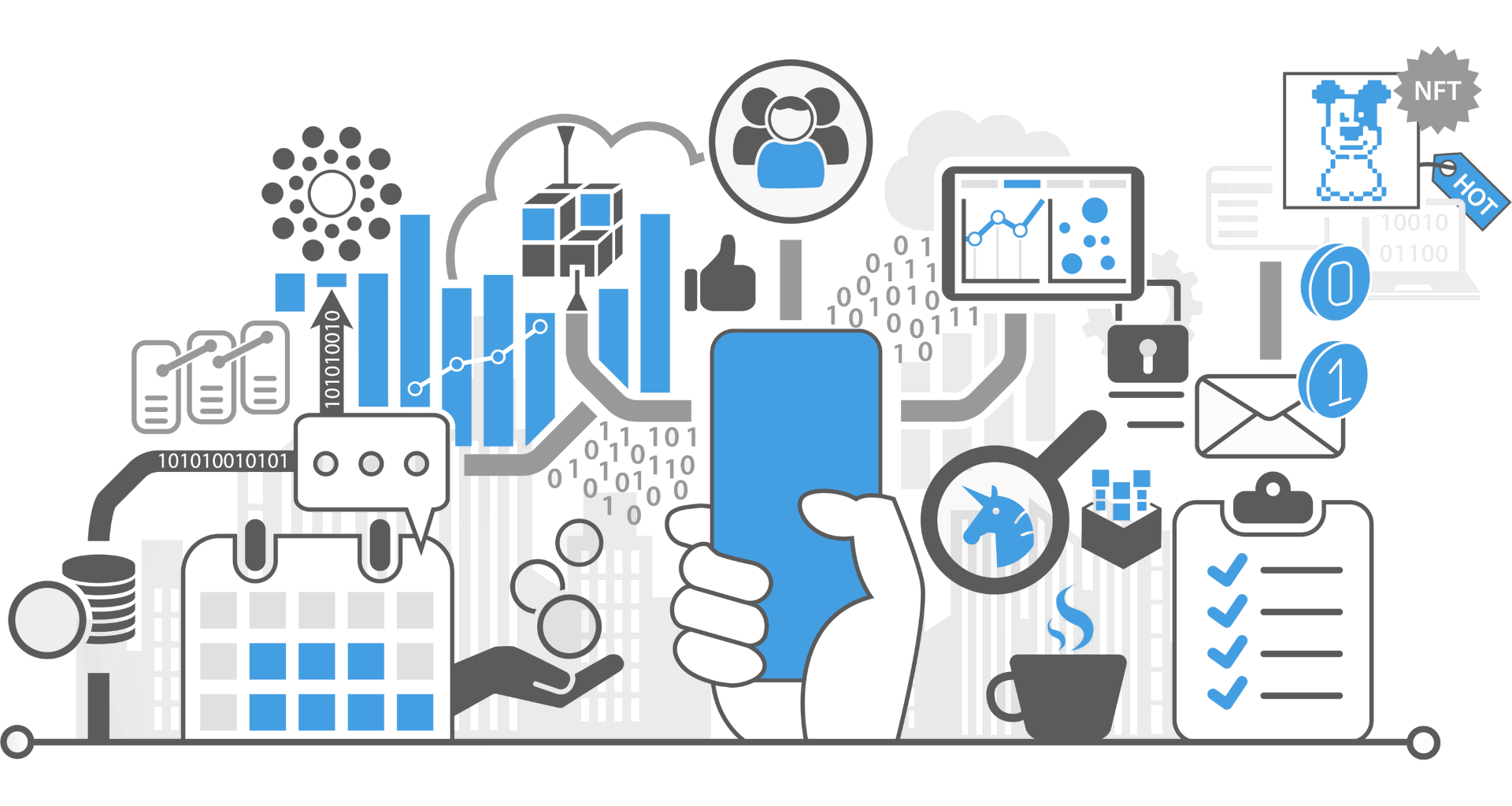In the early days of the internet, we had Web1—static websites that served as digital brochures. This evolved into Web2, where interactivity and social sharing became the norm. These models have served us well but are increasingly showing their limitations, especially in terms of centralized control and data security. Enter Web3, touted as the future of web development. It aims to offer a more decentralized, transparent, and secure way to experience the web.
What is Web3?
Web3, short for "Web 3.0," is often described as a new paradigm for applications on the internet. It brings fundamental changes to how we interact with, build, and experience websites and online platforms. Unlike previous versions of the web, Web3 enables peer-to-peer interactions without the need for centralized intermediaries. Key features include decentralized networks, blockchain technology, smart contracts, and enhanced security protocols.
Web2, or the "social web," was all about user-generated content, shareability, and increased interactivity. However, this interactivity often came at a price: your data stored on centralized servers, controlled by corporations.
Web3 aims to redistribute this power back to the individual. It uses blockchain technology to give users ownership over their own data, transactions, and online interactions.
While Web2 was a step forward in terms of interactivity and user engagement, Web3 takes it several leaps further by offering decentralization, enhanced security, and user ownership over data.
Why Web3 Matters
One of the most talked-about advantages of Web3 is decentralization. In the context of the web, decentralization means distributing authority away from a single, centralized entity. With Web3, this concept comes to life through blockchain networks and other decentralized technologies that ensure no single entity has complete control over the entire network.
The benefits are numerous. For starters, it enhances security by making it extremely difficult for any single point to be exploited for malicious activities. Moreover, decentralization enhances user privacy by giving individuals control over their own data, eliminating the need to rely on third-party services that may misuse or mishandle personal information.
Empowering Individual Users
Web3 places unprecedented power back into the hands of individual users. Through mechanisms like smart contracts, decentralized applications (dApps), and blockchain technology, users can perform transactions directly with one another without needing an intermediary, such as a bank or a tech giant, to validate those transactions. This not only speeds up the process but also eliminates or significantly reduces costs associated with these middlemen.
Additionally, this empowerment extends to ownership. In the Web3 framework, you own your data, your transactions, and even your identity to a large extent. This is a paradigm shift from the Web2 model, where your data essentially belonged to service providers like social media platforms or online retailers, who could then monetize it at will.
Web3 is not merely an incremental upgrade but a revolutionary approach that redefines the fundamental principles of digital interaction, making it more democratic, secure, and empowering for individual users.
Web3 Technologies
Blockchain
At the core of Web3's decentralized nature lies blockchain technology. Simply put, a blockchain is a distributed, immutable ledger that records all transactions across a network of computers. The decentralized nature of blockchain ensures that no single entity has control over the entire chain, thereby providing enhanced security and trustworthiness.
This technology serves as the foundation for many of Web3's most promising applications, including cryptocurrencies, smart contracts, and decentralized applications (dApps).
Smart Contracts
Smart contracts extend the utility of blockchains from merely recording transactions to automatically executing predefined actions when certain conditions are met.
These self-executing contracts run on a blockchain and remove the need for intermediaries, making transactions faster, cheaper, and more efficient. For instance, a smart contract could automatically release funds to a seller once a buyer confirms receipt of delivered goods, all without requiring manual approval or the involvement of a third party.
Decentralized Finance (DeFi)
One of the most revolutionary applications of Web3 technologies is in the realm of finance, aptly named Decentralized Finance or DeFi. Unlike traditional finance that relies on centralized institutions like banks and financial service providers, DeFi offers financial services directly on the blockchain.
This can include borrowing, lending, asset trading, and earning interest, all done in a permissionless and decentralized manner. The power of DeFi lies in its accessibility; with just an internet connection and a digital wallet, anyone can access financial services without the need for a traditional banking relationship.
Together, these technologies form the cornerstone of Web3, each contributing to its decentralized, user-empowering nature. As these technologies continue to mature, the range of applications they can support will only grow, heralding a new era of more open, secure, and equitable digital interactions.
Web3 in Web Development
Traditionally, web development revolved around centralized servers, data storage, and singular authority points. Web3 fundamentally shifts this paradigm by making decentralization its core principle. This changes how websites and web applications are built, operated, and interacted with.
For instance, data storage could be distributed, making it more secure and less susceptible to central points of failure. Authentication processes can be managed through blockchain, reducing reliance on single service providers like Google or Facebook for login services.
Essentially, the power and control shift from companies and centralized services to the individual user.
Tools & Languages Commonly Used in Web3 Development
When it comes to Web3, the toolset varies somewhat from conventional web development. Below are some of the commonly used tools and languages:
- Solidity
The programming language for creating smart contracts on the Ethereum blockchain. - Web3.js / Web3.py
JavaScript and Python libraries to interact with a local or remote Ethereum blockchain, allowing for the sending of transactions, reading of data, and so forth. - Truffle
A popular development framework for Ethereum that provides a suite of tools for deploying and testing smart contracts. - Ganache
A personal blockchain for Ethereum development that allows you to deploy contracts, develop applications, and run tests. - MetaMask
A browser extension that allows users to interact with Ethereum-enabled websites. - IPFS
InterPlanetary File System, a protocol and network designed to create a peer-to-peer method of storing and sharing hypermedia.
This shift to Web3 technologies invites a new set of skills and tools for web developers. Familiarity with blockchain concepts, cryptography, and peer-to-peer networking are becoming increasingly valuable as the Web3 ecosystem grows.
Whether you are a web developer looking to adapt to these changes or a business considering how Web3 could improve your operations, the impact of these new technologies is significant and worth your attention.
Web3 Use Cases
Decentralized Apps (dApps)
One of the most exciting applications of Web3 technology is the development of decentralized applications, commonly referred to as dApps. Unlike traditional web applications, which run on centralized servers, dApps run on blockchain or peer-to-peer networks. This makes them more secure, transparent, and resistant to censorship.
Popular dApps include decentralized exchanges (DEXs), lending platforms, and even decentralized social media platforms. As dApps are governed by smart contracts, there's an assurance of code transparency and direct peer-to-peer interaction without intermediaries.
NFTs
Non-Fungible Tokens, or NFTs, have recently taken the art and collectible world by storm. NFTs are unique digital assets verified using blockchain technology. Unlike cryptocurrencies such as Bitcoin or Ethereum, which are fungible and can be exchanged on a one-to-one basis, NFTs are unique or limited in quantity.
They have introduced a way to prove ownership and provenance of a wide range of items, from digital artwork and music to virtual real estate in digital environments. NFTs have the potential to advance copyright law, ownership, and even create new business models for artists and creators.
DAOs
Decentralized Autonomous Organizations (DAOs) are a form of organization represented by rules encoded as a computer program that is transparent, controlled by the organization members, and not influenced by a central government.
DAOs are the most effective way to establish digital companies and are typically set up to run blockchain projects. They serve as an open-source blockchain protocol governed by a set of rules, created by its elected members, that automatically execute certain actions without the need for intermediaries. This brings unprecedented transparency and democracy to the organizational structure.
Web3 is not merely a new way to build websites; it's a groundbreaking evolution that could fundamentally change how we interact with the web. From owning unique digital assets to participating in decentralized organizations, Web3 brings exciting new possibilities and opportunities for innovation.
Challenges and Considerations
Security Concerns
While Web3 brings the promise of decentralization and heightened security through blockchain, it's not entirely devoid of risks. Smart contracts, the self-executing contracts with the terms directly written into lines of code, are immutable once deployed. This means that any flaw or vulnerability in the code is there to stay, potentially leading to significant security issues.
Also, the decentralized nature of blockchain makes it a target for various types of attacks, such as 51% attacks, where an entity gains control of the majority of the network's mining power.
Scalability Issues
One of the significant hurdles that Web3 technology faces is scalability. Blockchains like Ethereum are notoriously slow when handling a large number of transactions, leading to high costs and slower confirmation times.
While there are scaling solutions in the works, such as layer 2 technologies and sharding, these are yet to be universally adopted and proven at scale. This scalability issue could potentially limit the types and sizes of applications that could effectively run on a Web3 framework.
Ethical Considerations
Lastly, the very thing that makes Web3 attractive—decentralization—also poses some ethical questions. For instance, who is accountable when something goes wrong in a DAO? How do we manage the carbon footprint of energy-intensive blockchain networks? The lack of regulation and oversight in a decentralized system can lead to ethical quandaries that society needs to address as the technology becomes more prevalent.
Navigating through these challenges requires a multifaceted approach that involves developers, users, and regulators. Understanding these considerations is crucial for anyone venturing into the Web3 space, either as a developer or an end-user.
How to Get Started with Web3 Development
Stepping into the realm of Web3 development can be both exciting and intimidating given the paradigm shifts it brings. However, there's a wealth of resources to guide you through this journey. Platforms like Solidity's official documentation, ConsenSys Academy, and the Ethereum Foundation's website offer comprehensive tutorials to get you started.
Online courses on platforms like Udemy, Coursera, and edX also provide in-depth training on blockchain and smart contract development. Blogs and YouTube channels dedicated to blockchain technology can also offer practical insights and real-world examples.
The Web3 development community is robust and welcoming, offering various platforms where you can seek advice, share your knowledge, or collaborate on projects. Discord channels, Subreddits like r/ethereum and r/solidity, and GitHub repositories are great places to connect with like-minded individuals.
Ethereum Stack Exchange is another excellent platform for getting specific queries answered. Meetups, webinars, and conferences on blockchain technology are also worth attending for networking and staying updated on the latest trends and developments in the Web3 space.
Web3 isn't just another tech buzzword; it's a fundamental shift that aims to redistribute the power dynamics of the internet, emphasizing user control and decentralization. From dApps to DAOs, NFTs to DeFi, Web3 is setting the stage for a more equitable and autonomous online experience, affecting not only developers but also everyday users.




